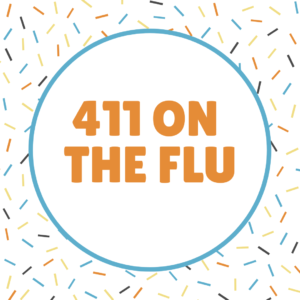The 411 on the Flu
It’s that time of year again…time to get your flu shot. With the kids back in school and freezing temps on the way, now’s the time to schedule your shot. Dr. Jessica Long gives us the lowdown on the flu and why it is so important to get vaccinated.
As a pediatrician, I see things through a different lens than the average parent. It’s a blessing and a curse. Back to school to me doesn’t just mean new clothes and backpacks – it means the swapping of germs with all your classmates. Grapes are tasty, nutritious choking hazards that must be cut into quarters. Monkey bars are fun and great for motor development but also keep emergency rooms in business. The long-awaited arrival of Fall means comfy sweaters and the rustle of fallen leaves…but also your flu shot is due! I can be such a killjoy, or so my husband says.
Flu peaks in the United States during December through March but we can see cases as early as September and as late as May. That’s what makes this time of year perfect for getting your annual flu vaccine since it takes two weeks to receive maximum protection from it. Just as in 2016, this year only the flu shot is available since the Flu Mist (the nose spray form of the vaccine) was not protecting people as much as we would like.
Avoiding contact with the flu virus is nearly impossible, so vaccination is the best way to ensure you do not get the flu this season. Flu spreads through droplets made when people cough, sneeze, or talk, making it very easy to share among your office, school or family. You can also get the flu by touching a surface or object that has the flu virus on it and then touching your own mouth, eyes or nose. In fact, the flu virus can live on a hard surface for 24 hours – gross!
Even though we all try to stay home and away from others when we are ill, you may have spread the flu before you were even sick! Most healthy adults can infect others with the flu one day before they have symptoms. People can remain infectious for 5-7 days after becoming sick. Some, like our young children, might be able to infect others for an even longer period of time.
Most people are familiar with the common symptoms of the flu (fever, cough, sore throat, stuffy nose, muscle aches, headache, and fatigue) but kids can also have vomiting and diarrhea. Our children are also more likely to develop “secondary infections” – a bacterial infection on top of the flu – such as an ear infection or pneumonia. And while we all know the flu is miserable, it’s easy to forget that for many of our friends and neighbors, especially infants and the elderly, it can be truly dangerous.
If all of this hasn’t convinced you to head over to your doctor’s office for the flu shot, remember that not only do you protect yourself with your vaccine but you also protect all of those important people around you from getting sick this flu season as well! Your kids will thank you for it!
How to Introduce Peanuts to Children

We all know that peanuts can be dangerous for children with peanut allergies, but when is the best time to begin introducing them to your child’s diet? Dr. Jessica Long gives us the lowdown on this tricky topic…
With two girls under the age of five, peanut butter is a staple in our house. It’s easy, delicious, and packs 8 grams of protein in a two tablespoon serving. However, for many families, peanuts are cause for real concern. Peanuts are the leading cause of food allergies in children and can cause serious allergic reactions and even anaphylaxis. For years, the medical community has been trying to figure out how best to prevent peanut allergy. Doctors used to advise parents to not expose their children to peanuts until they were at least two years old but that was not helping to decrease the number of people with allergies. Earlier this year, new recommendations came out in response to research showing that it’s actually early exposure, as opposed to late, that helps prevent peanut allergies.
So who do we now recommend try peanuts? Most healthy infants over the age of 4 months may benefit from early introduction of peanuts. However, some children may require allergy testing before trying peanuts so always discuss with your doctor before introducing new foods. For example, if your child has severe eczema or egg allergy, a peanut allergy test should first be done by 4-6 months old. Also, children with a strong family history of peanut allergy might need to see an allergist before trying peanut protein.
If your doctor gives the thumbs up for introducing peanuts to your baby, you can offer Bamba (a puff peanut product) or make your own thinned smooth peanut protein mixture. Combine two teaspoons of smooth peanut butter with two to three teaspoons of warm water or pureed baby food to make a perfect two gram serving which is the ideal amount for your little one.
The first feeding should be a small amount, just the tip of a teaspoon. Watch your infant for ten minutes to make sure there are no reactions such as hives, vomiting or nasal symptoms. If there are no reactions, continue to offer the rest of the 2 gram serving of peanut protein at your baby’s normal feeding pace.
Once your baby has successfully tried peanut protein, it is recommended that you offer two gram servings three or more times a week. If your infant develops any allergic symptoms within two hours of eating peanut protein, stop and contact your pediatrician. Remember to avoid whole nuts until kids are over 5 years old as well dollops of peanut butter until kids are over 4 years old due to choking concerns.
Solar Eclipse – Eye Safety
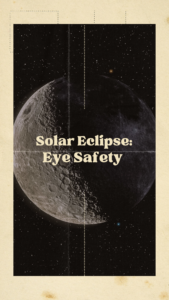 Thank you to the physicians at Children’s National Medical Center for providing these great tips for enjoying the upcoming solar eclipse safely.
Thank you to the physicians at Children’s National Medical Center for providing these great tips for enjoying the upcoming solar eclipse safely.
Eye Safety for Viewing a Solar Eclipse
On August 21, 2017, there will be a solar eclipse. People across the United States will fall under the path of this rare solar eclipse, and depending on their location, may witness a total solar eclipse. Eye safety is very important when viewing a solar eclipse. Without safe viewing and appropriate eye protection, permanent eye damage can occur. Eye experts at Children’s National have provided some vital information on what you can expect to see and how to view the eclipse safely.
What will I see during the eclipse?
During a total eclipse, the sun will gradually disappear behind the moon then reappear. The sun’s outer “corona” will be visible at this time. Depending on your location, a partial eclipse will be seen, which is when the moon covers a portion of the sun.
How long will the eclipse last?
The whole continent will experience a partial eclipse event, lasting 2 to 3 hours in which the moon will cover part of the sun. The total solar eclipse only lasts 2 to 3 minutes and can be seen within a 70-mile wide path from Oregon to South Carolina. The moon will completely block the view of the sun in this pathway.
How can the eye be damaged by viewing a solar eclipse?
The lenses in your eyes act like a magnifying glass, one that is 5 times more powerful than a handheld magnifier. Think about how you can use that typical handheld magnifier to focus the sun to burn holes in paper. That’s what happens when you look at the sun without appropriate eye protection. You focus the sun’s light on the retina, burning holes in light-sensitive photoreceptor cells, 5 times faster, and causing permanent blindness. Watching a partially eclipsed sun is when the damage occurs.
Do I need special equipment to view an eclipse?
Yes! Please be sure to follow these steps to protect your eyes from the partial eclipse:
- Anyone planning to view the eclipse should wear a pair of solar viewing glasses or handheld solar viewers that contain solar filters. Always supervise children using solar viewing glasses or viewers with solar filters.
- Using protective eyewear will allow observers to look directly at the sun during the eclipse. Sunglasses should not be used in place of solar viewing glasses– they will not protect your eyes from damage. Homemade filters are also not safe to use to look at the sun.
- Always inspect your solar filter before you use it – if it is scratched or damaged in any way, do not use it.
- Do not look at a partially eclipsed sun through an unfiltered camera, binoculars or telescope – even if you are wearing solar viewing glasses. A special filter is required to view without damage to your eyes.
Remember – no matter where you are to observe the eclipse, looking directly at the sun, especially when it is partially covered by the moon, can cause serious eye damage or even blindness.
What else should I know before viewing the eclipse?
Remember to be safe and enjoy this fascinating event! For more information you can visit the web site of the American Astronomical Society or the American Academy of Ophthalmology.
SCREEN TIME AND BABIES – ADVICE FROM A PEDIATRICIAN
We are all guilty of it…giving your child an iPad to get a small break during the day. Just how harmful is it? Keep reading for Spring Valley Pediatrics Dr. Jessica Long’s expert advice on how much (or how little) screen time is appropriate for our children.
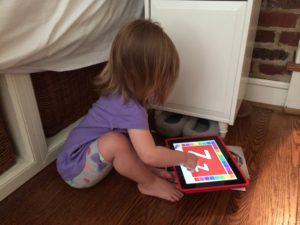
You are probably reading this on your phone, maybe catching a minute’s break during your baby’s afternoon nap or between answering emails. Texts, emails, adorable Instagram photos – there are plenty of reasons your phone is always within reach but what does it mean for your young child’s development?
We know that babies’ brains do a lot of growing and changing in the first years of life. From birth to two years old, a baby’s brain triples in size and is busy forming neural synapses (connections within the brain). Too little stimulation, as can happen to neglected children, causes the brain to under-develop. However, too much stimulation is also harmful to the maturing baby brain. Studies have shown that prolonged exposure to rapid image changes, like what is seen in children’s TV shows, during this critical period of brain development creates a mind that expects high levels of stimulation. This can lead to attention problems later in life; the more TV that is viewed before the age of 3, the more likely that child will have attention problems at age 7.
The American Academy of Pediatrics (AAP) recommends that, outside of video chatting with family, children under the age of 18 months have zero screen time. We know that children learn best through interacting with the people around them instead of with electronics. Exposing them to TV, tablets, and phones (including apps and shows that are meant to be educational) can actually cause children to speak later and use fewer words. Even having the TV on in the background, which many of us do when we are at home, can affect our baby’s language development. With the TV off, a parent speaks an average of 940 words per hour to a toddler. However, with background media on, the average is 170 words an hour, and important language tools such as facial expressions and body language are negatively affected.
So what is a busy parent, who deserves some down time scrolling through Facebook, to do? First, monitor your own use. When you are with your little one, put down your phone, turn off the TV, and give your child your undivided attention. Sing, read, and play with her. Make eye contact and use body language to communicate, all of which help her learn best.
Once your little one is 18-24 months old, the AAP gives the thumbs up to some screen time. Parents should choose high-quality programming and watch it with their child. Engaging your child in the viewing experience – asking questions, pointing things out, and helping him make connections to real life – make screen time more interactive.
I would be lying if I claimed to have never pulled out a tablet as a last resort on an airplane to calm a toddler throwing a tantrum. Every parent has been there, but do your best to avoid using screen time as an emotional pacifier. It’s important for your child to learn how to identify and handle strong emotions and to come up with activities to manage boredom or calm themselves down. The next time you are at a restaurant or in the doctor’s waiting room, let your child explore a new book, create a drawing with crayons, or play “I Spy” with you to pass the time instead of relying on a screen to keep her entertained. Added bonus – it gets you to put your electronics away, too, and I know I could benefit from some more unplugged time.
Car Seat Tips – Is your child in the right one?
Read on for Dr. Long’s car seat guidelines to ensure a safe and fun summer of road trips for your family.
Summer is fast approaching and for many families that means lots of fun hours in the car on road trips. No parent would ever knowingly put their child’s safety at risk, but that is what often happens when we buckle our kids in the car. More than 70% of car seats are improperly installed and at least half of caregivers are not correctly securing children in their car seats. All of this greatly reduces the ability of car seats and booster seats to protect your child.
So what can parents do? First, make sure your child is in the right seat for her or his height and weight by reading the info below. Second, double check that your seat is properly installed. Safe Kids DC has sites throughout the city where they do checks most days of the week. Spring Valley Pediatrics hosted a free car seat check with Safe Kids DC in May and will be hosting another in September. Third, use the right seat in the right way every time you are in the car.
One of the most common questions we are asked as pediatricians is when a child can move to the next type of car seat or booster seat. As parents, we look forward to our children growing, maturing, and making it to the next milestone. However, with car seats it’s best to go slow. Instead of looking forward to graduating to the next safety seat, aim to keep your child in their current car seat for as long as they meet the manufacturer’s height and weight restrictions.
We find parents excitedly turn their child front-facing long before it is safe to do so. Staying rear facing for as long as possible – up to 35-50 lb in most convertible car seats – is 5 times safer for your child in a collision. Your tall two year old may look like her legs cannot comfortably fit rear facing but you would be surprised by how happily kids adjust their positions in their car seats.
Similarly, the jump from a booster seat to the regular seat is one every 5th grader is anxious to make. To check if your child is ready to retire car seats and booster seats forever, see if he passes these steps. Can he sit with his back against the vehicle’s seat, knees bent at the edge of the seat, and feet flat on the floor? Is the lap belt positioned over his thighs (not his belly) and the shoulder belt positioned across the shoulder and chest (not his neck or face)? Also importantly, can he sit properly with no slouching, moving around, leaning forward, or playing with the seatbelt? If so, you can consider ditching the booster forever but, as always, no need to rush things. They grow up fast enough.
Car seats do expire, typically six years from their manufacturing date, due to gradual breakdown of the materials and daily strain from installations and use – so be sure to check the date on the side or back of your car seat. You should also replace your safety seats if your car is in an accident, even if there is no visible damage to the car seat or your child was not riding in it at the time. Purchasing a new one is crucial to ensure your child continues to travel safely. Also, replace your car seat if there is obvious wear and tear – the straps are frayed or the harness doesn’t latch as well – since these are signs that it would not properly protect your child in an accident. As tempting as it is, never purchase a used car seat. There is no way to ensure that it is top condition and has never sustained damage in a car accident.
Still have questions? There is a lot to know about car seats and recommendations change as more medical and scientific data become available. Use your pediatrician as a guide and resource for how to keep your kids safe in all aspects of their life. We make it our job to help parents protect their little ones!
The Right Seat For Every Age
Birth to 12 months: a rear-facing car seat is the perfect spot for your little one. Infant, convertible and 3-in-1 car seats are all options for safely securing your baby. Infant car seats (aka “bucket seats”) can be used up to the first year of life or until your baby outgrows the height and weight recommendations, whichever happens first. Convertible and 3-in-1 car seats can last longer but be sure to follow the manufacturer’s guidelines on height and weight requirements.
1 to 3 years: your little one is still safest rear-facing. Most convertible and 3-in-1 car seats can still be used during this age. Switch your child to front-facing once she reaches the maximum height or weight limit for the car seat. Some convertible car seats can accommodate a child up to 80lbs in the front facing position so make sure you pick a color or pattern you adore because you’ll
be seeing it for years to come!
4 to 7 years old: your school age child has likely grown to safely ride front-facing. Continue to use the five-point harness until they reach the height and weight restrictions of the seat. Combination seats (a hybrid car seat that can turn into a booster), convertible car seats, or 3-in-1 car seats should still accommodate your growing child.
8 to 12 years old: Though your child might seem so grown up, it is unlikely that he is ready to ditch safety seats altogether. A booster seat is best at this age. They come in many different shapes and sizes, with and without backs, and work with your car’s seatbelt to keep your child safe in the car.
13 and up: While the safest place in the car for your teen is in the back seat, a child of this age may legally sit in the front passenger seat.
Fun in the Sun – Safety Tips
Protecting our family from the sun’s harmful rays is constantly on our minds during the Summer months. Dr. Long offers us some tips on how to keep everyone safe and sunburn-free this Summer.

D.C. summer is finally upon us and longer days (and no school!) mean lots more time outside. Getting some extra sunshine is great for the whole family; just make sure a sunburn doesn’t get in the way of your vacation. Here are tips to keep each member of your family – from the littlest baby to the most seasoned grandparent – from regretting their fun in the sun this summer.
Babies’ skin is thinner and more sensitive than adults’ and requires more vigilance in protecting it. If you are out and about with your little one, try to avoid the sun from 11am-3pm when the rays are strongest. Dress your baby in loose lightweight clothing when possible – long sleeves and pants will protect them better – and do your best to keep your baby shaded. Don’t forget the adorable wide brimmed sun hat and glasses!
Sunscreen is important for every member of your family. Choose one that advertises “broad spectrum” – meaning it will help block UVA and UVB rays – and go for at least SPF 30. Look for ingredients like zinc oxide or titanium dioxide, which are physical barriers, meaning they sit on top of your skin and reflect UVA and UVB rays away like a mirror. These ingredients are especially helpful for protecting sensitive parts of your body like your nose, cheeks, tops of the ears, and shoulders. All family members older than 6 months should be lathered up at least 15-30 minutes before heading outside to ensure that the sunscreen is absorbed and ready to protect. No sunscreen is truly waterproof so be sure to reapply after drying off from the pool or ocean as well as every 1 ½ – 2 hours.
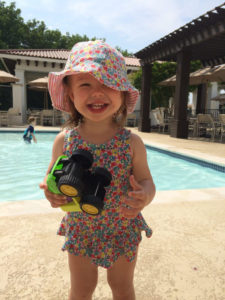
While we tend to be most vigilant about covering up our babies, putting on breathable, comfortable clothing that covers the body is a good choice for all family members. Clothes with a tight weave will protect you from the sun’s rays better than loose weave items. Invest in UPF (ultraviolet protection factor) clothing which is manufactured specifically to better protect the skin from UVA and UVB rays and might be a good choice for children, those with sensitive skin, or anyone planning on spending a lot of time outdoors.
If a sun burn does happen, first make sure to get out of the sun! Protecting burnt skin while it heals is important so be sure to either avoid the sun or cover the burnt area when outside. If your child’s burn is red, warm and painful, you can treat it yourself with cool compresses (such as a cool washcloth applied directly to the skin), aloe gel, and ibuprofen. However, if there are blisters or your child has fever, chills, headache or generally does not feel well, call your pediatrician. Professional medical care may be needed for more serious burns.
When it comes to protecting your and your children’s skin this summer, preparation and vigilance are key. Toss hats, sunglasses, and some sunscreen in a Ziploc in your bag. Apply sunscreen even on cloudy days since 80% of the sun’s rays can get through clouds. And reapply, reapply, reapply.
Happy Summer!

Epipen Recall
The U.S. Food and Drug Administration is alerting consumers to Meridian Medical Technologies’ voluntary recall of 13 lots of Mylan’s EpiPen and EpiPen Jr (epinephrine injection) Auto-Injector products used for emergency treatment of severe allergic reactions. This recall is due to the potential that these devices may contain a defective part that may result in the devices’ failure to activate. The recalled product was manufactured by Meridian Medical Technologies and distributed by Mylan Specialty.
While the number of reported failures is small, EpiPen products that potentially contain a defective part are being recalled because of the potential for life-threatening risk if a severe allergic reaction goes untreated. Consumers should keep and use their current EpiPens if needed until they get a replacement. Consumers should contact Stericycle at 877-650-3494.
As stated on the product label, consumers should always seek emergency medical help right away after using their EpiPens, particularly if the device did not activate.
At this time, the 13 lots identified – distributed between Dec. 17, 2015, and July 1, 2016 – are the only EpiPen lots impacted by the U.S. recall. Consumers who have EpiPens from lots that are not included in this recall, do not need to replace their EpiPen prior to its expiration date.
| Product/Dosage | NDC Number | Lot Number | Expiration Date |
|---|---|---|---|
| EpiPen Jr Auto-Injector, 0.15 mg | 49502-501-02 | 5GN767 | April 2017 |
| EpiPen Jr Auto-Injector, 0.15 mg | 49502-501-02 | 5GN773 | April 2017 |
| EpiPen Auto-Injector, 0.3 mg | 49502-500-02 | 5GM631 | April 2017 |
| EpiPen Auto-Injector, 0.3 mg | 49502-500-02 | 5GM640 | May 2017 |
| EpiPen Jr Auto-Injector, 0.15 mg | 49502-501-02 | 6GN215 | September 2017 |
| EpiPen Auto-Injector, 0.3 mg | 49502-500-02 | 6GM082 | September 2017 |
| EpiPen Auto-Injector, 0.3 mg | 49502-500-02 | 6GM072 | September 2017 |
| EpiPen Auto-Injector, 0.3 mg | 49502-500-02 | 6GM081 | September 2017 |
| EpiPen Auto-Injector, 0.3 mg | 49502-500-02 | 6GM088 | October 2017 |
| EpiPen Auto-Injector, 0.3 mg | 49502-500-02 | 6GM199 | October 2017 |
| EpiPen Auto-Injector, 0.3 mg | 49502-500-02 | 6GM091 | October 2017 |
| EpiPen Auto-Injector, 0.3 mg | 49502-500-02 | 6GM198 | October 2017 |
| EpiPen Auto-Injector, 0.3 mg | 49502-500-02 | 6GM087 | October 2017 |
The FDA asks health care professionals and consumers to report any adverse reactions or device malfunctions to the FDA’s MedWatch program, by:
- Completing and submitting the report online at www.fda.gov/medwatch/report.htm, or
- Downloading and completing the form, then submitting it via fax at 800-FDA-0178.
The FDA, an agency within the U.S. Department of Health and Human Services, protects the public health by assuring the safety, effectiveness, and security of human and veterinary drugs, vaccines and other biological products for human use, and medical devices. The agency also is responsible for the safety and security of our nation’s food supply, cosmetics, dietary supplements, products that give off electronic radiation, and for regulating tobacco products.

Daylight Savings Tips
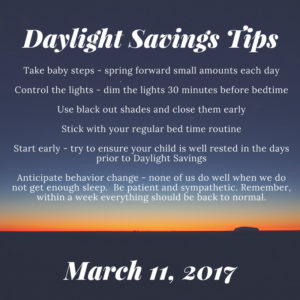
Take baby steps – spring forward small amounts each day
Control the lights – dim the lights 30 minutes before bedtime
Use black out shades and close them early
Stick with your regular bedtime routine
Start early – try to ensure your child is well rested in the days prior to Daylight Savings
Anticipate behavior change – none of us do well when we do not get enough sleep. Be patient and sympathetic. Remember, within a week everything should be back to normal.
Dr. Joanna Sexter is published in the February 2017 issue of Pediatrics Journal
Increasing Awareness of Sudden Death in Pediatric Epilepsy Together
As seen in Pediatrics Journal
February 2017, VOLUME 139 / ISSUE 2
Lapham G, Gaillard WD, Sexter J, et al. Increasing Awareness of Sudden Death in Pediatric Epilepsy Together. Pediatrics. 2017; 139(2):e20163127
Abbreviation:
SUDEP — sudden unexpected (or unexplained) death in epilepsy persons
The death of any child is tragic. When the death is sudden and unexpected, it can seem especially incomprehensible. Henry was 4 years old when he died only a few weeks after his epilepsy diagnosis; his parents were devastated and never knew that death could occur; no physician had discussed the possibility with them. Henry was an otherwise healthy child, had a history of febrile seizures, and died in his sleep before his epilepsy workup was complete and before his medication was likely therapeutic. Since Henry’s death 8 years ago, together and independently, Henry’s parents, pediatrician, and neurologist have sought understanding and opportunities to advance awareness and prevention around epilepsy-related mortality. These efforts have launched a multidisciplinary partnership between Children’s National Health System and the University of Virginia to develop an educational research program to systematically raise provider and patient awareness of sudden unexpected (or unexplained) death in epilepsy persons (SUDEP) and other risks associated with epilepsy. This article gives voice to these different experiences and underscores the value of families and providers working together to improve care and prevent death.
Although epilepsy is a common childhood disorder, all of us were impacted by Henry, who died, suddenly and unexpectedly, as a result of his seizure disorder. Our partnership started with Henry’s mother, Henry’s pediatrician, and Henry’s neurologist and now includes an educational research program that incorporates parent advocacy, nursing, neuropsychology, psychiatry, neurology, and basic science expertise.
Henry’s Mother
As a bereaved mother, I was desperate to make sense out of our tragedy. I searched for understanding and connection to others who shared my experience and ultimately connected with other parents at Citizens United for Research in Epilepsy. I joined their efforts to fund epilepsy research, including SUDEP, and raise awareness about the devastating effects of epilepsy. Through this experience, I learned that rigorous scientific pursuit can affect change and that families can play an important role in the process. One effort that I am especially proud of is my work with other families and professionals to create Partners Against Mortality in Epilepsy, a biannual scientific meeting for families and professionals that seeks to advance SUDEP research and prevention strategies by bringing different stakeholders together to learn from one another. Through these efforts and others, I have met many bereaved family members and the most consistent thing I hear is that they wish they had known about SUDEP. I have more recently had the opportunity to engage with my son’s care team, who also cares deeply about this fundamental gap in knowledge. Most families want to know all risks associated with epilepsy and providers face barriers (ie, lack of knowledge, lack of time) when meeting these needs. Together, we are working to educate local providers and families about the risks associated with epilepsy and arm them with knowledge to mitigate harm and death.
Henry’s Pediatrician
As Henry’s pediatrician, it was not until a conversation with Henry’s mother that I heard the term SUDEP for the first time. I had no experience with a child ever dying from epilepsy, nor was this something I ever discussed with parents. Since Henry’s death, I am more cautious during the early stages of a diagnosis of epilepsy, when medication may not yet be at a therapeutic level. A specific change that I have instituted since learning about SUDEP is stressing, especially to parents of children with nocturnal and tonic clonic seizures, the importance of medication adherence, because seizure control is the best way to minimize SUDEP risk. I make sure that parents are working with their neurologist to achieve this goal. I also now talk with parents about nighttime supervision and monitoring options, which I previously had not discussed. There is 1 study that demonstrates the benefit of nighttime supervision,1 and I discuss with families the range of possibilities, including using an infant monitor, having the child sleep in the same room, or having a nighttime sitter. The benefit of sleeping in the same bed rather than using an infant monitor is that the adult may be able to detect the child’s seizure better if the seizure can’t be seen or heard on an infant monitor. With all supervision methods, there is the opportunity to be able to intervene to stop the seizure and assure safety. The drawbacks of nighttime supervision in the form of cosleeping include potential disruption to family dynamics and developmental socialization and that it is considered one of the greatest risks in sleep-related infant deaths. Nighttime supervision is costly when hiring a nighttime sitter that is not the parent, and disrupts sleep schedules if it is the parent; however, closer monitoring may only be needed on a short-term basis until there is confidence regarding the level of control and frequency of seizures. In addition to supervision, there are ongoing studies regarding monitoring devices, which include monitoring heart rate and respiration. The hope is that an alarm could alert the parents, who could then go in the child’s room and ensure that the child is in a safe position and administer a rescue medication as needed. The drawbacks are that these devices are still under investigation and current devices may give families a false sense of security or produce too many false alarms. Ultimately, the family will decide how to monitor seizures by considering the costs and benefits of available options. Regardless, I recommend that the family have rescue medications on hand in case of prolonged or clusters of seizures.
Discussing these options with patients and their families introduces them to the term SUDEP and underscores the importance of treatment adherence. During these conversations, I encourage parents to discuss mortality risk with their child’s neurologist. Collaboration among pediatricians and pediatric neurologists is critical to the successful treatment and education of our patients with epilepsy and their families; however, we appreciate that in more rural environments, this may present a challenge due to distance. Yet another reason that the primary care physician needs to be well informed.
Henry’s Neurologist
As Henry’s neurologist, I was taught during my pediatric and neurology training that epilepsy is a benign disease and that when children die, the cause is primarily from the underlying disease (eg, brain tumor, degenerative, or metabolic disease). Henry proved, sadly, that epilepsy can be deadly and is not a benign disease. In fact, 24% of patients with childhood onset epilepsy will die within 40 years, 3 times the expected mortality rates.2,3 Before Henry’s death, I would wait for families to raise their fears, to the extent they occurred, by asking them nonspecifically if they had any questions. If the concern for mortality was not raised, I would often defer the conversation for another visit, if at all. After Henry’s death, I still wait patiently for families to raise their own questions and fears, but if that question does not arise before the close of a clinic visit, I now directly ask what their greatest fear is, and it is invariably harm from seizures and death. When there is no response to my question, then I ask directly, “Do you fear your child will be harmed or die from their seizures?” Capable and skilled physicians do not often discuss mortality.4, Yet, families wish to discuss these matters at the first visit, not later, and expect their doctor to do so.5,6 This is part of our duty and responsibility as physicians. For many children who have “uncomplicated” epilepsy, the data may be reassuring because most children’s risk of death is similar to all children, although death in this low-risk population can occur.3 SUDEP incidence is lowest in young children, but is higher in adolescence (cumulative risk, 1.6%), and peaks in younger adulthood (ages 31–40 years).7 The overall risk is 33 per 100 000 patient years, but 9 per 100 000 patient years if uncomplicated (normal exam, normal MRI, no developmental disability).3 For other children, if epilepsy begins in early childhood and never fully remits, the average cumulative risk of SUDEP is ∼8% by age 70 years.7 The large majority who die will do so from their underlying disease and from pulmonary failure. Of the 15% to 20% of epilepsy-related deaths, the large majority are SUDEP-related, but suicide should not be forgotten.3 Those at highest risk of death (97 per 100 000 patient years) have early epilepsy onset and frequent generalized tonic clinic seizures (the risk declines with
Developing Our Partnership
Henry’s story and those of others who have died unexpectedly are a wake-up call that there is too much we do not know. It became clear to all of us that education is our most powerful tool and that we do not need to wait for all of the answers before we start preventing SUDEP. At the time of Henry’s death, searches for information on the internet came up empty; since then, there are resources for providers and families with information about the facts, prevention strategies, printed brochures, and how to talk about SUDEP (www.epilepsy.com/learn/impact/mortality/sudep).10 Despite this progress, work still remains to be done. Over several meetings, we developed our first project that brings together many areas of expertise and seeks to change primary and specialty care provider knowledge and practice. On a local level, we are implementing systems that will lead to improved quality of care and, ultimately, we aim to change outcomes. Our work has leveraged local foundation funding and we are connected with broader, federally funded efforts that delineate the risks of SUDEP, examine possible mechanisms of SUDEP (including cardiac failure, cardiac arrhythmia [eg, channelopathies], central apnea, autonomic instability, and pulmonary edema), and, most importantly, identify effective monitoring and devise interventions to decrease mortality. We support efforts to work with medical examiners to recognize epilepsy as a cause of death, promote registries that include DNA collection, and develop clinical and translational research to advance understanding.
Our partnership between families and providers has played a significant role in highlighting care and education areas that needed strengthening and, in the case of SUDEP, needed to be brought out of the shadows entirely. Moreover, our work together has shaped a program of research that includes a novel first finding that 85% of pediatricians do not know about SUDEP.11 Through their energy and drive, Henry’s family has worked closely with our institution and private foundations to promote important SUDEP initiatives. Their efforts, along with those of so many other families and providers, have accelerated the study of an important field (mortality in epilepsy) and, in doing so, have enabled the National Institutes of Health to fund a significant multicenter SUDEP research effort (http://csr.case.edu/index.php/Main_Page). Furthermore, these efforts have helped to create a scientific committee within the American Epilepsy Society dedicated to SUDEP, additionally solidifying the importance of this issue within our community. When families and providers unite, they can more efficiently impact multiple levels of research and care that advance understanding and action around the full scope of a disease.
Spring Valley Pediatrics
Monday – Friday
9:00am to 5:00pm
Saturdays, Sundays, and Holidays:
Sick visits available
For Medical Emergencies Please Call 911

